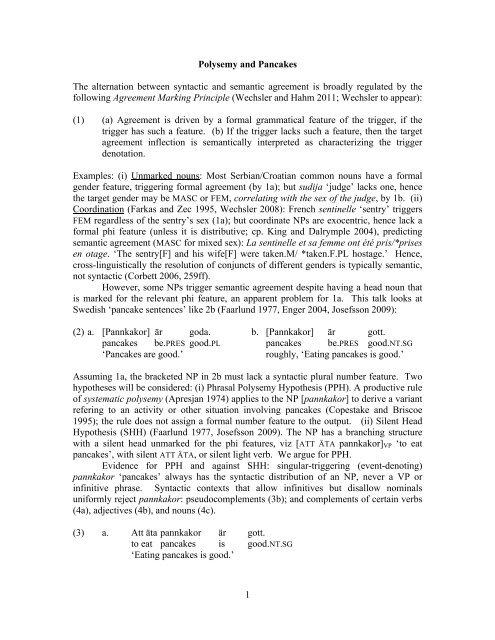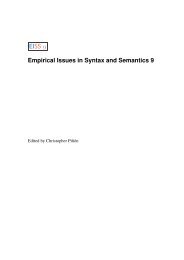Polysemy and Pancakes - CSSP
Polysemy and Pancakes - CSSP
Polysemy and Pancakes - CSSP
You also want an ePaper? Increase the reach of your titles
YUMPU automatically turns print PDFs into web optimized ePapers that Google loves.
<strong>Polysemy</strong> <strong>and</strong> <strong>Pancakes</strong><br />
The alternation between syntactic <strong>and</strong> semantic agreement is broadly regulated by the<br />
following Agreement Marking Principle (Wechsler <strong>and</strong> Hahm 2011; Wechsler to appear):<br />
(1) (a) Agreement is driven by a formal grammatical feature of the trigger, if the<br />
trigger has such a feature. (b) If the trigger lacks such a feature, then the target<br />
agreement inflection is semantically interpreted as characterizing the trigger<br />
denotation.<br />
Examples: (i) Unmarked nouns: Most Serbian/Croatian common nouns have a formal<br />
gender feature, triggering formal agreement (by 1a); but sudija ‘judge’ lacks one, hence<br />
the target gender may be MASC or FEM, correlating with the sex of the judge, by 1b. (ii)<br />
Coordination (Farkas <strong>and</strong> Zec 1995, Wechsler 2008): French sentinelle ‘sentry’ triggers<br />
FEM regardless of the sentry’s sex (1a); but coordinate NPs are exocentric, hence lack a<br />
formal phi feature (unless it is distributive; cp. King <strong>and</strong> Dalrymple 2004), predicting<br />
semantic agreement (MASC for mixed sex): La sentinelle et sa femme ont été pris/*prises<br />
en otage. ‘The sentry[F] <strong>and</strong> his wife[F] were taken.M/ *taken.F.PL hostage.’ Hence,<br />
cross-linguistically the resolution of conjuncts of different genders is typically semantic,<br />
not syntactic (Corbett 2006, 259ff).<br />
However, some NPs trigger semantic agreement despite having a head noun that<br />
is marked for the relevant phi feature, an apparent problem for 1a. This talk looks at<br />
Swedish ‘pancake sentences’ like 2b (Faarlund 1977, Enger 2004, Josefsson 2009):<br />
(2) a. [Pannkakor] är goda.<br />
pancakes be.PRES good.PL<br />
‘<strong>Pancakes</strong> are good.’<br />
1<br />
b. [Pannkakor] är gott.<br />
pancakes be.PRES good.NT.SG<br />
roughly, ‘Eating pancakes is good.’<br />
Assuming 1a, the bracketed NP in 2b must lack a syntactic plural number feature. Two<br />
hypotheses will be considered: (i) Phrasal <strong>Polysemy</strong> Hypothesis (PPH). A productive rule<br />
of systematic polysemy (Apresjan 1974) applies to the NP [pannkakor] to derive a variant<br />
refering to an activity or other situation involving pancakes (Copestake <strong>and</strong> Briscoe<br />
1995); the rule does not assign a formal number feature to the output. (ii) Silent Head<br />
Hypothesis (SHH) (Faarlund 1977, Josefsson 2009). The NP has a branching structure<br />
with a silent head unmarked for the phi features, viz [ATT ÄTA pannkakor]VP ‘to eat<br />
pancakes’, with silent ATT ÄTA, or silent light verb. We argue for PPH.<br />
Evidence for PPH <strong>and</strong> against SHH: singular-triggering (event-denoting)<br />
pannkakor ‘pancakes’ always has the syntactic distribution of an NP, never a VP or<br />
infinitive phrase. Syntactic contexts that allow infinitives but disallow nominals<br />
uniformly reject pannkakor: pseudocomplements (3b); <strong>and</strong> complements of certain verbs<br />
(4a), adjectives (4b), <strong>and</strong> nouns (4c).<br />
(3) a. Att äta pannkakor är gott.<br />
to eat pancakes is good.NT.SG<br />
‘Eating pancakes is good.’
. Det är gott {[att äta pannkakor]/ *pannkakor}<br />
it is good to eat pancakes pancakes<br />
‘It is good to eat pancakes.’<br />
(4) a. Jag fortsatt {[(att) äta pannkakor] / *[pannkakor]}.<br />
I continued (to) eat pancakes pancakes<br />
‘I continued to eat pancakes.’ / ‘*I continued pancakes.’<br />
b. Jag är villig {[att äta pannkakor]/ *[pannkakor]}.<br />
I am willing to eat pancakes pancakes<br />
‘I am willing to eat pancakes.’ / ‘*I am willing pancakes.’<br />
c. Jag har lust {[att äta pannkakor]/ *[pannkakor]}.<br />
I have desire to eat pancakes pancakes<br />
‘I want to eat pancakes.’<br />
(lit. I have desire to eat pancakes./ *I have desire pancakes.)<br />
(5) Det är gott med {*[att äta pannkakor]/ [pannkakor]}.<br />
it is good with to eat pancakes / pancakes<br />
roughly, ‘Eating pancakes is nice.’<br />
The contrasts in 3-5 are unexpected if pannkakor can be a covert infinitive. Hellan<br />
(1986:96) notes another problem for SHH: the putative source 6b is infelicitous:<br />
(6) a. Vodka er sunt å drikke. (Norwegian)<br />
vodka[MASC] is healthy.NT.SG to drink<br />
‘Vodka is healthy to drink.’<br />
b. *Å drikke vodka er sunt å drikke.<br />
(‘To drink vodka is healthy to drink.’)<br />
Josefsson (2009, 43), arguing for SHH, notes that pancake-NPs can contain reflexive<br />
pronouns which, she suggests, are bound by the PRO subject of a silent ‘light verb’:<br />
[hemfärd till USA utan sin dotter] ‘hometravel to USA without self’s daughter’. But<br />
such reflexives can also be bound within NPs in Swedish, by genitives or by implicit<br />
agents, so these data do not favor either hypothesis.<br />
Either hypothesis allows us to preserve 1a. Alternatively, 1a may be replaced by<br />
a Bayesian version in which the syntactic <strong>and</strong> semantic features are allowed to compete<br />
probabilistically (Pearl 1988, 49ff; Kjaerulff <strong>and</strong> Madsen 2007, 25ff).<br />
Selected References: Copestake, A., <strong>and</strong> T. Briscoe. 1995. Semi-productive <strong>Polysemy</strong> <strong>and</strong> Sense<br />
Extension. J of Sem 12, no. 1: 15. • Enger, H-O. 2004. Sc<strong>and</strong>inavian pancake sentences as<br />
semantic agreement. Nordic J of Ling 27, no. 01: 5-34. • Faarlund, J.T. 1977. Embedded clause<br />
reduction <strong>and</strong> Sc<strong>and</strong>inavian gender agreement. J of L: 239-257. • Josefsson, G. 2009. Peas <strong>and</strong><br />
<strong>Pancakes</strong>: On apparent disagreement <strong>and</strong> (null) light verbs in Swedish. Nordic J of Ling 32, no.<br />
01: 35-72. • Wechsler, S. (in press). ‘Mixed Agreement, the Person Feature, <strong>and</strong> the<br />
Index/Concord Distinction.’ NLLT. • Wechsler, S. <strong>and</strong> H.-J. Hahm 2011. ‘Number Markedness<br />
<strong>and</strong> Polite Plurals’. Morphology 21:247–281.<br />
2











